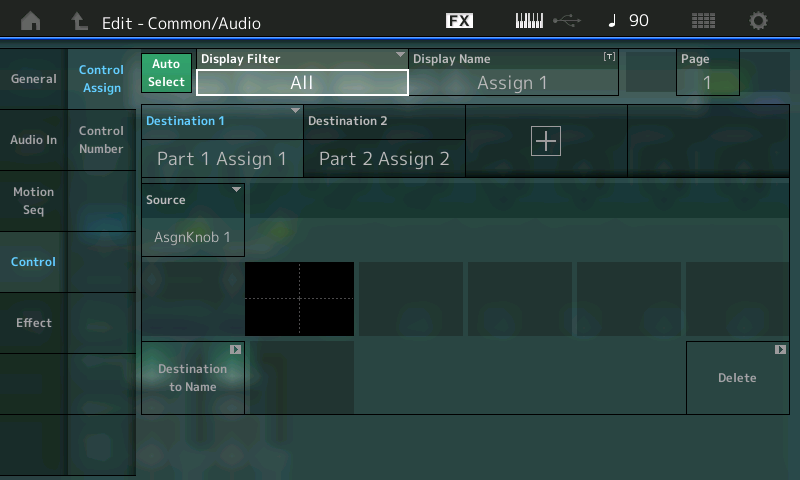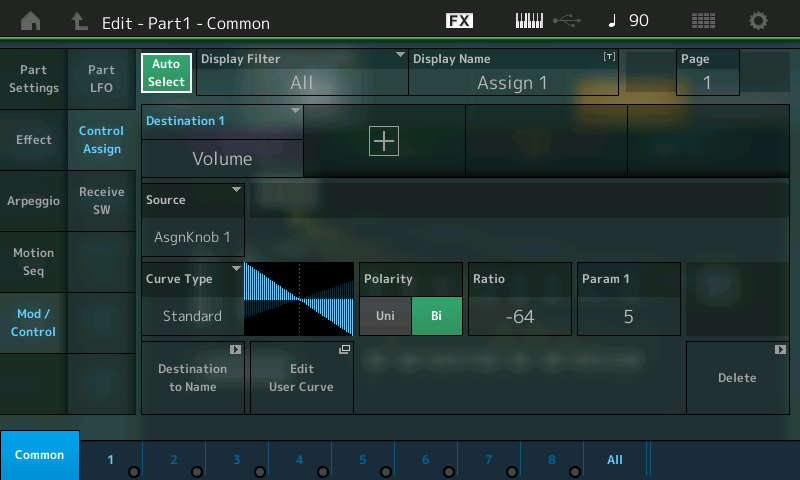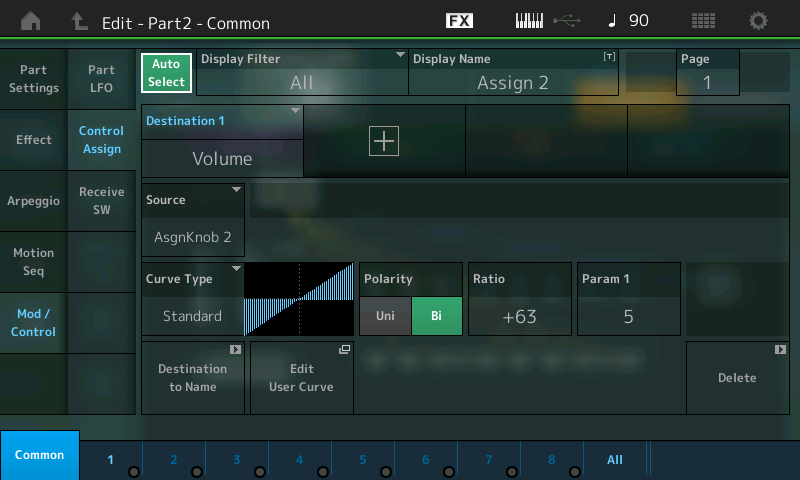As a learning project, I've been setting up a jazz quartet consisting of drums, bass, piano, vibes. I'm using the Bosendorfer Imperial Grand for the piano (Parts 3-5) and the Vibraphone Motorized for the vibes (Parts 6-7). Part 1 is the drums, Part 2 is the bass.
I'm currently trying to see if I can get the Super Knob set up to fade me between the piano and the vibes -- i.e. all the way counter-clockwise would be just the piano, all the way clockwise would be just the vibes, and in between would be the two of them combined in proportions that changed as I turned the Super Knob. The idea is that the sound would transition smoothly from piano to vibes, etc.
What I have currently succeeded in setting up is the Super Knob controlling Assignable Knobs 1 and 2 in opposite directions. All the way counter-clockwise on the Super Knob sets Assignable Knob 1 all the way clockwise and Assignable Knob 2 all the way counter-clockwise. As I turn the Super Knob clockwise, Assignable Knob 1 rotates counter-clockwise and Assignable Knob 2 rotates clockwise.
I have Assignable Knob 1 set up in Parts 3-5 to control the Volume, and Assignable Knob 2 set up in Parts 6-7 to control the Volume.
As far as I know, this ought to work. But it doesn't. What happens when I rotate the Super Knob clockwise is that the piano sound gets softer but doesn't go all the way to zero. And the vibes just aren't there at all no matter where I position the Super Knob.
For the moment I'm stumped, and I'm hoping someone can point me in the right direction. Am I going about this in anything like the right way?
Diving into the deep end of the pool, while enticing, can lead to confusion and frustration. We recently completed our first Montage Training tour in which we trained store staff, and in-house staff on the Montage. One very important point was made that seems appropriate here: when attempting to show splitting or layering or any such thing... (very common requests at the point-of-purchase) Super Knob assignment included... in general: don't select the most complex sounds... where you first must study and understand what you are "inheriting". Start with two simple single Part sounds.
1) easier to follow and thus easier to understand
2) less likely to be tripped up by what you are inheriting (or must reprogram)
3) by learning first the basic concept, you THEN can go forward and tackle the more complex. If you can "morph" between two Parts then morphing among five Parts is less daunting. Just saying... The series hope to wade you out into the deeper waters (but so far you seem on point...)
Once the basics are clearly understood, then you will be less likely to be tripped up by what you inherit from the original programmer's work. In our series on "Programming Basics" which starts with the Super Knob programming... Thus far we have seen how on the upper "COMMON/Audio" level of editing the Super Knob automatically is set change the 8 Assignable (Common) Knobs. At the upper "Common/Audio" level of editing you can assign Destinations that affect *all Parts* together, similarly. This include things like System wide effects (Reverb/Variation; the Master FX, Master EQ, etc.,) and the Audio In Part is handled here.
Turning one Part up and another Part down, therefore, must be done on a deeper level, the PART level of programming. In order to introduce this deeper individual Part assignments, we first learned to link a Part's Knob to this upper Common level.... We started by assigning Part 1's Assignable Knob ("Part 1 Assign 1" ) to the Super Knob on the upper COMMON/Audio level before dropping down to the Part level of Editing to select a target parameter Destination (Control Assign).
We also have begun to explore the UniPolar and BiPolar application of controllers.
UniPolar is used to start at minimum and turn up, or start at maximum and turn down. One directional movement. It does not always mean silence to maximum, but can start at a predetermined setting and be increased or decreased from that point in one general direction.
BiPolar is used to change values in either direction from the staring point. But can also be used to start at max to turn something down, or start at minimum and turn something up... So it can be used to have both sounds active in the center, if desired. I recommend BiPolar for morphing Piano to Vibraphone. You can STORE the Super Knob in any position you like. If stored at 12 o'clock (two sets of LEDs light) both the Piano and Vibraphone will be in together.
In order to control the Volume of a Part, you've linked the Part's Assignable Knob to movement of the Super Knob.
In order to control the Volume of another Part, you've linked its Assignable Knob to movement of the Super Knob.
What is not clear is exactly "how" you set the minimum-to-maximum of Vibraphone versus the maximum-to-minimum of the Piano.
Here's how: Morphing between sounds can probably be handled several different ways... but using the Control Matrix to fade out a Part could look like this (from the "Programming Basics" tutorial Sound Set, provided with the tutorials, find the Performance: "Super Knob Morph A" (which will be covered in a featured future article) but this is a good one to study and play around with, again, because you will inherit little else in the program it makes it easier to grasp and hear the results of your experiments.
In the "SUPER KNOB MORPH A" Performance we use Assignable Knob 1 to control one Part (Sawtooth) We fade it out
We use Assign Knob 2 to control the other. (Square) We fade it in
So on the Common/Audio level of editing our two assignment are as follows: ("Display Filter" set to show ALL)

We use the BiPolar function to turn one Part down... PART 1 Sawtooth: As you can see the graphic indicates this sound is IN (left) and fades out as you move (right) the control..

...and the other Part up... PART 2 Square: As you can see the graphic indicates this sound is OUT (left) and fades in as you move the control..

...You've complicated it by jumping to multiple Parts, is all.
How to proceed:
On your "Common/Audio" level of programming you'll need the following Destinations (linking Part Assign Knobs to the movement of the Super Knob):
Part 3 Assign 1 (Piano) controls soft strike piano
Part 4 Assign 1 (Piano) controls mid strike piano
Part 5 Assign 1 (Piano) controls hard strike piano
Part 6 Assign 2 (Vibraphone)
Part 7 Assign 2 (Vibraphone)
Then in each of those Parts you must setup the "Control Assign" so that the Piano PARTs 3, 4 and 5, are BiPolar (-64);
Set the Vibes PARTs 6 and 7 to BiPolar (+63).
This will have the effect of having the Piano in when the Super Knob is at 0 and the Vibes in when the Super Knob is at 127 and they will crossfade in the middle.
You can control how severe the fade-out and fade-in happen, by shaping the curve using "Param1" (parameter 1).
Hint: Piano "7", Vibes "3" makes a nice blend of both in the middle movement of the Super Knob.
By "inheriting" parameters from pre-made sounds, you will probably wind up editing something else with your Super Knob movement. But this is the general idea - tweak and change to your liking. If the original programmer already has somethings happening you can DELETE a Controller Assignment on the screen in the lower right corner (DELETE). This will allow you to reprogram that DESTINATION as you desire.
Press [STORE] and name your PERFORMANCE "Modern Jazz Quartet" !!! 
Hope that helps.
Thanks, Bad Mister.That really helped. I have it "working" now, except that my simple setup screws up the relative volumes of the three Bosendorfer Parts. So that's the next challenge. I like it in the deep end…
Can you explain some more about the difference between UniPolar and BiPolar? I used BiPolar as you suggested, and was happy for the tip. But I really have no idea why BiPolar is a better choice in this situation. I think it might be helpful if you explained what the vertical axis represents in the associated curve graph.
I started out building a jazz trio -- drums, bass, piano. Then it occurred to me it would be fun to also have vibes as part of it. I hadn't realized that I was re-creating the MJQ until you mentioned it. They were one of my favorite jazz groups. I was really happy that I got to go to their "Last Concert" at Lincoln Center in NYC.
Bag's Groove indeed!
The next in the series is Bipolar.
Unipolar = one direction
Bipolar = either direction
Basically the decision for Unipolar or Bipolar will depend on the start position of the Super Knob and the kind of control you require musically. If it starts at left, Unipolar is more useful. If it starts at center position, Bipolar is recommended.
